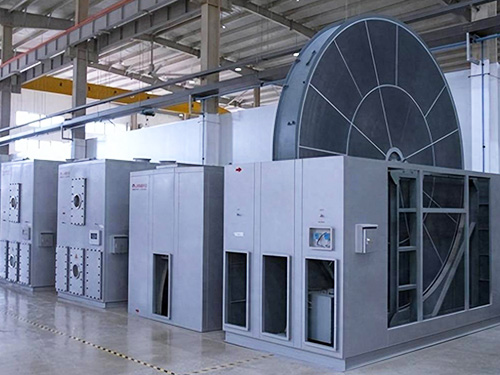Zeolite Rotary Combustion EquipmentThrough The Dust Removal Barrier System. Separate The Exhaust Gas Into Carbon Dioxide And Water, And Enter The Heat Exchanger To Exchange Heat With The Low-temperature Gas, Causing The Temperature Of The Incoming Gas To Rise To The Reaction Temperature. Then It Enters The Heat Exchanger And Is Sent Back To The Heating Chamber. The Gas Reaches The Combustion Reaction Temperature And, Under The Action Of The Catalyst Bed, Uses The Catalyst As An Intermediate. When The Reaction Temperature Cannot Be Reached, The Heating System Compensates For The Heating Through An Automatic Control System. Convert Gas Into Stable Water And Carbon Dioxide Gas At Low Temperatures.
Technical Principle Of Zeolite Rotary Combustion Concentration And Incineration
The Zeolite Rotary Combustion Concentration And Incineration Process Is Divided Into Adsorption Zone, Desorption Zone, And Cooling Zone. After The High Air Volume And Low Concentration Organic Vapor Passes Through The Adsorption Zone, The Organic Molecules Are Adsorbed On The Surface Of The Molecular Sieve. When The Adsorption Reaches A Certain Degree, A Low Air Volume High-temperature Gas Is Used For Reverse Blowing To Remove The Organic Molecules From The Molecular Sieve. At The Same Time, Some Low Concentration Organic Vapor Is Used To Cool The Molecular Sieve. Through The Above Steps, The Organic Vapor Is Concentrated And Separated, And The High Air Volume And Low Concentration Organic Vapor Is Converted Into High Concentration And Low Air Volume Waste Gas.
Zeolite Rotary Combustion Concentration Adsorption Utilizes The Crystalline And Porous Structural Characteristics Of Zeolite Molecules To Selectively Adsorb Organic Waste Gas Molecules And Air Molecules, Achieving The Goal Of Evolving Air.
The Surface Of Zeolite Molecules Is A Solid Skeleton, And The Pores Are Connected To Each Other By Pores. Gas Molecules Can Pass Through The Pores. Due To The Crystallization Characteristics Of The Pores, The Pore Distribution Of The Molecular Sieve Is Uniform, And The Pore Size Is Relatively Uniform.
When Gas Molecules Pass Through The Pores, They Selectively Adsorb Based On The Size Of The Pore Size Inside The Crystal. Larger Molecules Are Adsorbed On The Surface Of The Crystal, While Smaller Molecules Become Clean Air Through The Pores. Therefore, Zeolite Wheels Are Also Known As "molecular Sieves".
Zeolite "molecular Sieve" Has A Large Specific Surface Area, Which Is Mainly Located Inside The Crystal Cavity, With The Outer Surface Area Accounting For Only About 1% Of The Total Surface Area. Therefore, It Has Excellent Adsorption Function And Can Effectively Adsorb Smaller And More Polar VOC Organic Molecules Such As Hydrocarbons And Alkanes.
Core Principle Of Zeolite Rotary Combustion Equipment:
The Core Principle Of Zeolite Rotary Catalytic Combustion Equipment Is To Catalyze And Adsorb VOC Molecules, Thereby Increasing The Concentration Of Reactants.
During The Catalytic Oxidation Stage, The Reaction Decreases And The Reaction Rate Increases. Compared With Direct Combustion, Zeolite Rotary Catalytic Combustion Equipment Has The Characteristics Of Low Ignition Temperature And Low Energy Consumption. Sometimes, External Heating Is Not Required After Reaching The Ignition Temperature. The Exhaust Gas Undergoes Anaerobic Combustion Under The Action Of The Catalyst At A Lower Ignition Temperature, Turning Into CO2 And H2O And Releasing A Large Amount Of Heat. The Reaction Temperature Is 250-400.
During The Industrial Production Process, The Exhaust Gas Is Blown Into The Rotary Valve Of The Equipment Through A Fan. The Zeolite Rotary Catalytic Combustion Equipment Selects The Rotary Valve To Separate All The Incoming And Outgoing Gases. The Exhaust Gas Continues To Heat Up In The Heating Zone And Remains At The Set Temperature; Further Entering The Catalyst Layer For Catalytic Oxidation Reaction, That Is, The Reaction Generates CO2 And H2O, Releasing A Large Amount Of Heat. After Preheating The Gas Through The Ceramic Material Filling Layer, Heat Accumulation And Heat Exchange Occur, And The Temperature Almost Reaches The Temperature Set For Catalyst Oxidation. At This Time, A Part Of The Pollutants Are Oxidized; The Purified Exhaust Temperature Is Slightly Higher Than The Temperature Before Exhaust Gas Treatment. The System Runs Continuously And Switches Automatically. The Zeolite Rotary Catalytic Combustion Equipment Achieves The Expected Treatment Effect Through The Operation Of The Rotary Valve. The Gas After Catalytic Oxidation Enters Other Ceramic Filling Layers, And After Recovery, It Is Discharged Into The Atmosphere Through A Rotary Valve. All Ceramic Filling Layers Complete The Heating And Purification Cycle Process, And The Heat Is Deeply Recovered.
4. Zeolite Rotary Catalytic Combustion Equipment Catalytic Combustion Method Is Suitable For Purifying High Concentration And Low Air Volume Exhaust Gas. When Treating Low Concentration Exhaust Gas, It Is Necessary To Increase The Combustion Heat Value Of The Exhaust Gas Through Concentration Processes Such As Carbon Adsorption To Maintain A Catalytic Combustion Temperature Of 300-400




